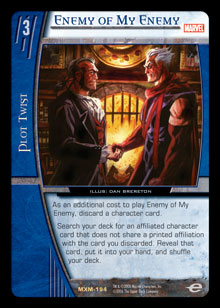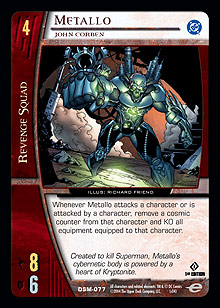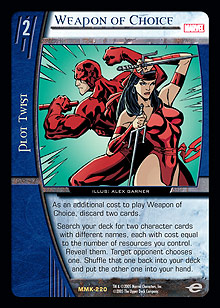It is a sad fact of life that money does, indeed, make the world go ’round. The almighty (insert your local denomination) has an impact on almost every aspect of our lives. To some people, money is everything; to others, it is less important. But there is no escaping the fact that moola, dosh, wonga, wedge, cash—whatever you want to call it—is very important.
I am sure there are people who play this game purely for the potential cash return that the awesome Pro Circuit offers. To each his own, I say. While prize money may not be a consideration for the casual player, cash in general certainly is.
 There is a rampaging bull crashing through fences and picking up momentum in the world of Vs. System. Enemy of My Enemy has become the card to own . . . and as its popularity increases, so does its price. I recently did a search on eBay for some Enemy of My Enemy auctions, and I found that the lowest winning bids were all around the $40 mark. If you look at commercial websites, many are asking for in excess of $50 per card! That sort of money is obscene and can quickly price players out of the game. But who is to blame for such high prices? Upper Deck? Of course not. The retailers? No—they’re entitled to make as much as they can. No, I’m afraid that if you’re looking to find someone to blame for such high prices, start with the man in the mirror.
There is a rampaging bull crashing through fences and picking up momentum in the world of Vs. System. Enemy of My Enemy has become the card to own . . . and as its popularity increases, so does its price. I recently did a search on eBay for some Enemy of My Enemy auctions, and I found that the lowest winning bids were all around the $40 mark. If you look at commercial websites, many are asking for in excess of $50 per card! That sort of money is obscene and can quickly price players out of the game. But who is to blame for such high prices? Upper Deck? Of course not. The retailers? No—they’re entitled to make as much as they can. No, I’m afraid that if you’re looking to find someone to blame for such high prices, start with the man in the mirror.
I’m sure many of you are choking on your cheesy puffs right now, but I’m afraid it’s true. The only people that can be held accountable are the players. After all, if we all refuse to pay $50 for a single card, what do you think the retailer will do? Do you honestly think he will sit there hoarding his cardboard stash? A retailer will charge whatever amount a consumer is willing to pay. Of course, Enemy of My Enemy is not the first card to have such a high price tag. Savage Beatdown was the first real “money card” of the game, and it commanded fees not too dissimilar to those of Enemy of My Enemy. But what is it that makes these cards so valuable?
“I’d Buy That for a Dollar!”
There are three main factors that generally affect the price of an individual card: playability, collectability, and availability. Very often these three factors intertwine, and generally you’ll have either playability or collectability as the primary concerns, with availability coming in as a secondary influence. The determining factors really depend on the type of Vs. System enthusiast you are. Basically we can pigeonhole people into two categories: player and collector. Of course it is not quite as black and white as that, but it’s a decent enough starting point. The player’s priority is to accumulate cards that can be used in viable decks. The collector’s priority is to complete his collection—be it extended arts, foils, misprints, or just getting a copy of each and every card.
We can look back to the inception of DC Modern Age at Pro Circuit Indy (2005) for an example of the playability/availability mechanism at work. The now defunct Team Realmworx took its Shadow Creatures deck to the event. It was a strong deck that used Kiman and Qward to dispose of the swarming little guys that made up the incredibly popular “GLEE” deck. Here is an excerpt from Jason Grabher-Meyer’s deck analysis at the time:
The Shadow Creatures are the raw fuel on which the deck runs. In the early game, they start off by fulfilling the conditions for The Ring Has Chosen and Emerald Dawn while pumping the deck’s pilot full of endurance thanks to Sector 2814. As the game progresses, they can act as fodder for Element Man’s effect in order to cycle through the deck, and they provide bodies for Evil Star to feed off of in order to dish out big KOs (a great way to deal with Sinestro, Green Lantern of Korugar).
Team Realmworx had nineteen copies of that little uncommon from the Green Lantern Corps set in the deck, so as people began to netdeck, they inevitably became harder to come by. This increased demand allowed retailers to raise their prices, especially in the weeks after the Pro Circuit. In the end, I saw some websites selling Shadow Creatures for around $10-$15—a price absolutely unheard of for an uncommon.
A few months ago, U.K. and other European players had access to previously unreleased Extended Art (EA) cards. Catwoman, Selina Kyle was given to those who participated in a European X-Men Sneak Preview event. A short while later an EA version of Emma Frost, Headmistress of Xavier's Academy was awarded to the finalists of a City Championship tournament—another European exclusive. Due to the limited worldwide availability, these cards were able to command high prices on eBay auctions or trade deals as EA collectors scrambled to get their hands on them.
“Guess You Think You’re Pretty Smart, Huh? Think You Can Outsmart a Bullet?”
 Enemy of My Enemy has become so valuable due to its playability. It has opened up a wealth of options in deckbuilding and has changed the game in a profoundly positive way. It allows deckbuilders to include “silver bullets,” or random characters that would not normally fit into a deck but are able to swing a game in a particular matchup. For example, Metallo, John Corben is not a card you’d expect to see in a PC-winning deck, but Enemy of My Enemy allowed Ian Vincent to include a copy in case he came up against those pesky Fate Artifacts. In Silver Age, Enemy of My Enemy is extremely powerful, and given that the current format is SA, the price of this flexible search card is through the roof—so high, in fact, that some people have called for it to be banned. This, to me, would be a ridiculous reaction. Enemy of My Enemy does not make any one deck overpowered; it makes all sorts of decks viable. Just look at the Top 8 decklists from all the most recent tournaments, and you will see cards and deck types that have never been seen before. Surely that is good for the game!
Enemy of My Enemy has become so valuable due to its playability. It has opened up a wealth of options in deckbuilding and has changed the game in a profoundly positive way. It allows deckbuilders to include “silver bullets,” or random characters that would not normally fit into a deck but are able to swing a game in a particular matchup. For example, Metallo, John Corben is not a card you’d expect to see in a PC-winning deck, but Enemy of My Enemy allowed Ian Vincent to include a copy in case he came up against those pesky Fate Artifacts. In Silver Age, Enemy of My Enemy is extremely powerful, and given that the current format is SA, the price of this flexible search card is through the roof—so high, in fact, that some people have called for it to be banned. This, to me, would be a ridiculous reaction. Enemy of My Enemy does not make any one deck overpowered; it makes all sorts of decks viable. Just look at the Top 8 decklists from all the most recent tournaments, and you will see cards and deck types that have never been seen before. Surely that is good for the game!
If you read my first Metagame.com article, you will know that I am not from a gaming or comic background. My first experience of the TCG world was through trading and selling cards. I’ve been trading since then, and I find it an incredible way to get those cards that I really want. There are plenty of websites that provide facilities for their members to trade online, and although it’s not without its risks, it can be the most cost-effective way to get the cards you want.
Online Trading
Before you enter into the world of online trading, you must accept that occasionally, something may go wrong. Your cards may get lost in the post, or you may fall foul of a “ripper” (someone who obtains cards from you with no intention of sending their part of the deal). There are measures you can take to limit the chances of this, but nothing is foolproof.
1) Are you a collector or player? You have to decide what is most important to you. Do you want to hang onto those EAs, or are you prepared to trade them for that Enemy of My Enemy?
2) Decide what you want. Before you begin trading, set yourself a clear list of targets or “wants.” Know what it is you are after and what you are prepared to trade for that card.
3) Reputation is everything. Most websites recommend that traders operate to a “ref” rule. Basically, whenever someone successfully completes an online trade, he or she is given a good reference by the person he or she traded with. If you want people to trade with you, you must earn a good reputation.
4) Sending Priority. If you agree to a trade with someone who has more refs than you, that person may ask you to send first. This is quite normal; do not be offended by it. However, if you are not comfortable sending first, why not suggest using an “escrow”? Both traders choose a neutral party (normally a well-respected trader) and send their cards to that escrow agent. Once the escrow receives the cards, he will then forward them on to the two traders. This way, if one person doesn’t live up to the bargain, the escrow simply returns the cards, and nothing is lost. I have personally acted as an escrow many times for new traders, and it really is the safest way to begin your trading career.
5) Overseas trading. Do not be afraid of overseas trading. It really isn’t any more complicated than domestic trades. Postage does cost slightly more, but it certainly won’t break the bank. Many people who will not trade overseas cite the length of time as a reason against. The vast majority of my online trading has been between the U.K. and the U.S., and many of my trades have been totally completed within six working days.
6) Postage. Makes sure that you always send your packages with a method of protecting your cards. Toploaders (hard plastic sleeves) are the best bet, and bubble-wrapped envelopes are good as well. Sending a poorly packaged trade can earn you a negative reference—especially if the cards end up damaged. If you want to save a little cash on your postage costs, try recycling those padded envelopes. When you receive a trade in one, open it carefully, and you can reuse it. That’ll keep the tree-huggers and your bank manager happy.
7) Seek out collectors. Collectors will often give you “over the odds” for a card if they want it for their collections. Even simple foil copies of a card can earn you more. I am currently in the middle of a trade where I am exchanging my two foil versions of Enemy of My Enemy for two nonfoil versions plus half a dozen other rares.
 Those are just a few tips for getting on the road to online trading—but what exactly should you trade for? That all depends on what you’re after, but every trader should have a couple of “chase” cards in his collection. Cards like Enemy of My Enemy are massive bargaining tools. But how do you get them in the first place? The easiest way is to look for potential money cards in new sets. If you can get in early—before the price goes up—then you’re laughing. The types of cards to look out for are search cards (Enemy of My Enemy), generic power-ups (Savage Beatdown), negation cards (Fizzle) and resource control (Have a Blast!). Those sorts of cards always do well in the early days of a set, but you must keep in touch with the community. Vs. System players are a fickle bunch, and a card’s popularity can fall just as quickly as it rose. When Marvel Knights was released, Weapon of Choice was an incredibly popular card and was being traded at a very high rate. Then, when people began to realize that it was not quite as powerful as they first thought, its stock fell. You have to know when to get out, and listening to the online community is the best way to do this. When X-Men was released, it was blatantly obvious to everyone including my Gran (who doesn’t play Vs., and is in fact dead) that Enemy of My Enemy would be popular. I was lucky enough to pull two from packs, but I quickly traded for the other two. I managed to get a pair for what equates to approximately $15 worth of cards, thus proving that if you get in early, there are some real bargains to be had.
Those are just a few tips for getting on the road to online trading—but what exactly should you trade for? That all depends on what you’re after, but every trader should have a couple of “chase” cards in his collection. Cards like Enemy of My Enemy are massive bargaining tools. But how do you get them in the first place? The easiest way is to look for potential money cards in new sets. If you can get in early—before the price goes up—then you’re laughing. The types of cards to look out for are search cards (Enemy of My Enemy), generic power-ups (Savage Beatdown), negation cards (Fizzle) and resource control (Have a Blast!). Those sorts of cards always do well in the early days of a set, but you must keep in touch with the community. Vs. System players are a fickle bunch, and a card’s popularity can fall just as quickly as it rose. When Marvel Knights was released, Weapon of Choice was an incredibly popular card and was being traded at a very high rate. Then, when people began to realize that it was not quite as powerful as they first thought, its stock fell. You have to know when to get out, and listening to the online community is the best way to do this. When X-Men was released, it was blatantly obvious to everyone including my Gran (who doesn’t play Vs., and is in fact dead) that Enemy of My Enemy would be popular. I was lucky enough to pull two from packs, but I quickly traded for the other two. I managed to get a pair for what equates to approximately $15 worth of cards, thus proving that if you get in early, there are some real bargains to be had.
While Vs. System may not be about money for some of us, we can’t play the game without having at least a little bit of it. If you want to change the nature of online pricing, it must be done as a community. While a handful of people are still willing to pay $50 for a single card, the online retailers will rightly charge $50. My personal rule is to never pay more than $20 for a single card.
Deckbuilder Challenge Cup #3
Next week I will announce the final standings for the “Counter Crazy” challenge. This week, though, it’s time to announce the third challenge. In keeping with the theme of today’s article, we are going to have a “Pauper format” for this challenge.
Deckbuilder Challenge #3 – Poor Man’s Vs. System
Rules:
1) This challenge is Golden Age.
2) 60 card minimum, current ban list is applied
3) Your deck may include NO RARES.
4) Your deck may include only 8 uncommons.
5) You must include a short description or summary of your deck.
Simple enough, huh? Absolutely no rares are to be used, and only eight uncommon cards are allowed. As always, be sure to include the full name and version of any card you use. Please include an overview of how your deck is intended to work. It need only be a short description, but I reserve the right to edit it for grammar and clarity. As always, you can submit your decks to me via email or post them on my website (www.the-kamiza.com).
Happy trading,
Steve Garrett